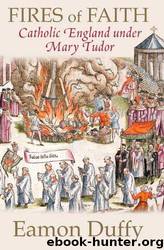Fires of Faith: Catholic England under Mary Tudor by Eamon Duffy

Author:Eamon Duffy
Language: eng
Format: mobi, epub
ISBN: 9780300108286
Publisher: Yale University Press
Published: 2014-12-12T00:00:00+00:00
CHAPTER 7
The Battle for Hearts and Minds
John Foxe's partisan artistry and the paucity of other sources has made it hard for the historian to assess the actual impact of the burnings on those who witnessed them. The most famous of the executions, that of Bishops Ridley and Latimer in the town ditch of Oxford on 16 October 1555, is a case in point. The culmination of a series of disputations involving theologians and canon lawyers from both universities, and of a show trial attended by a large lay audience, the execution itself was a carefully staged event, designed in part to silence the most influential of all the protestant leaders, and to focus the wavering mind of Thomas Cranmer, then imprisoned in the town gaol, ‘Bocardo’, on the wisdom of recantation. The Regius Professor of Divinity, Richard Smith, preached a short sermon beside the pyre on the text: ‘If I yield my body to the fire to be burned, but have not charity, I gain nothing’ (see Plate 24). In it, he compared Latimer and Ridley's deaths to the suicide of Judas, traced their heresies to the alien teachings of Luther, Oecolampadius and Zwingli, and warned the people against contamination from contact with or sympathy for those who died wilfully outside the church. The two victims themselves were prevented by the sheriff from making any reply, but commended themselves to God by crying out ‘in a wonderful loud voice’ the dying words of Jesus on the cross. But the most famous element in the scene, Latimer's ringing words to his companion at the stake, ‘Be of good comfort maister Ridley, and play the man: wee shall this day light such a candle by Gods grace in England, as (I trust) shall neuer be put out’, appears, sadly, to be pure invention, added by Foxe in the 1570 edition of Acts and Monuments, and modelled on the words of the early church martyr Polycarp at his burning by the pagan Roman authorities.1 The impact of this execution at the time on those who watched it is therefore hard to judge. Cardinal Pole thought that the spectators had by and large accepted the justice of the execution.2 Foxe, in contrast, attributed the conversion of the future martyr Julins Palmer, fellow of Magdalen College, to horror at this burning, on his return from which ‘in the hearing of diuers of his frendes, he brast out into these woordes, and suche like: O raging crueltie, O tyrannie tragicall, and more than barbarous’, and from that day forward ‘studiously sought to vnderstand the truth’.3 In fact, although in Edward's days he had been a stubborn papist whose views had cost him his college fellowship, by the beginning of Mary's reign Palmer had already changed his mind. A reading of Calvin's Institutes during his Edwardine exile had convinced him that all images were idols, the pope antichrist, and the catholic clergy ‘the filthy sinke hole of hel’.4 No doubt the deaths of Latimer and Ridley revolted
Download
Fires of Faith: Catholic England under Mary Tudor by Eamon Duffy.epub
This site does not store any files on its server. We only index and link to content provided by other sites. Please contact the content providers to delete copyright contents if any and email us, we'll remove relevant links or contents immediately.
| Buddhism | Christianity |
| Ethnic & Tribal | General |
| Hinduism | Islam |
| Judaism | New Age, Mythology & Occult |
| Religion, Politics & State |
Cecilia; Or, Memoirs of an Heiress — Volume 1 by Fanny Burney(31357)
Cecilia; Or, Memoirs of an Heiress — Volume 3 by Fanny Burney(30954)
Cecilia; Or, Memoirs of an Heiress — Volume 2 by Fanny Burney(30909)
The Secret History by Donna Tartt(16681)
Sapiens: A Brief History of Humankind by Yuval Noah Harari(13089)
Leonardo da Vinci by Walter Isaacson(11927)
The Radium Girls by Kate Moore(10929)
Sapiens by Yuval Noah Harari(4560)
The Wind in My Hair by Masih Alinejad(4431)
How Democracies Die by Steven Levitsky & Daniel Ziblatt(4430)
Homo Deus: A Brief History of Tomorrow by Yuval Noah Harari(4294)
Endurance: Shackleton's Incredible Voyage by Alfred Lansing(3859)
The Silk Roads by Peter Frankopan(3795)
Man's Search for Meaning by Viktor Frankl(3657)
Millionaire: The Philanderer, Gambler, and Duelist Who Invented Modern Finance by Janet Gleeson(3577)
The Rape of Nanking by Iris Chang(3531)
Hitler in Los Angeles by Steven J. Ross(3450)
The Motorcycle Diaries by Ernesto Che Guevara(3349)
Joan of Arc by Mary Gordon(3272)
